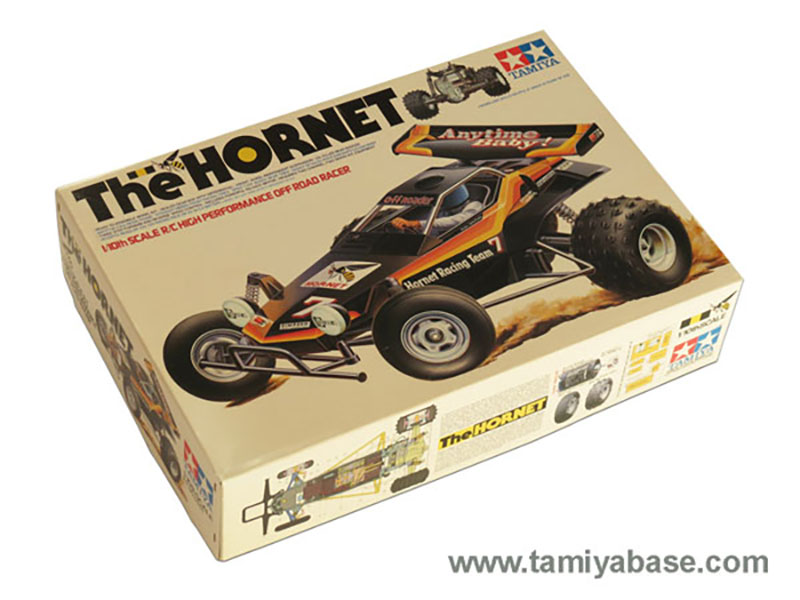It only seems right that the first Tamiya R/C model I post about should be the Tamiya Hornet, as I really do consider it to be the most iconic of all Tamiya’s amazing R/C models over the years.
First released on the 9th of October, 1984, I suspect it went on to become Tamiya’s biggest selling R/C car ever – although I have no specific proof. Tamiya has never released any sales figures. But the impression I got growing up in Australia was that this was by far the most popular Tamiya buggy of the era. And combine that with the fact that it was available for 8 years from 1984-1992, and there’s no doubt it had an incredible sales run.
A quick note about Tamiya’s re-released models… like many classic Tamiya models, The Hornet has actually been re-released in altered form in recent years. At first you might think it’s exactly the same, but there are actually many changes – altered electronic parts, altered plastic parts (mostly from new/different molds), altered decals that no longer feature real world sponsor logos, no mechanical speed control, even altered box art. Tamiya’s various re-releases have all contained differences to the original models. This article (and in fact this website) will only ever discuss the original models.
Tamiya Hornet Re-release
The re-released Tamiya Hornet (2005) contains many differences to the original 1984 release. In my view, it also lacks a lot of it’s charm.
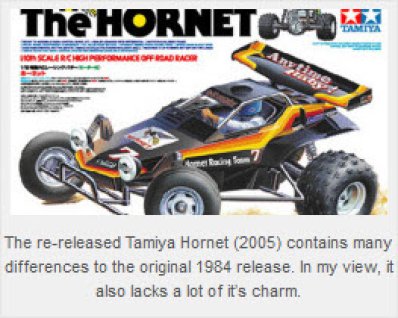 I personally don’t have much interest in the re-released Tamiya cars. They seem to have satisfied enough fans to cause the price of original examples to fall a bit, making it more affordable to restore a true original – which is great. But other than that, they’ve saturated online hobby shops and eBay with what are essentially tribute models that aren’t quite the same as building and driving an original (and in a few cases, they look truly hideous compared to the originals).
I personally don’t have much interest in the re-released Tamiya cars. They seem to have satisfied enough fans to cause the price of original examples to fall a bit, making it more affordable to restore a true original – which is great. But other than that, they’ve saturated online hobby shops and eBay with what are essentially tribute models that aren’t quite the same as building and driving an original (and in a few cases, they look truly hideous compared to the originals).
Much as if say, Pink Floyd re-recorded “Dark Side of the Moon” this year and it was being played on the radio again – would we consider the new mix as important as the original release? Yes it would introduce Pink Floyd to new listeners, and I understand the re-release Tamiyas offer a cheap, brand-new thrill for those looking for an out-of-the-box kit experience. But nothing will ever surpass an original release for it’s cultural impact or it’s place in history. And besides, there’s a lot to be said for the fun and the challenge of hunting down true original parts and restoring an old Hornet to “as it was back in the day” condition – and it doesn’t always cost as much as you’d think.
But moving on now… let’s look at Tamiya model number #58045, The Hornet.
I actually don’t have a built Hornet worthy of display just yet, so this article will feature images of one of my new-in-box original kits…
Because, speaking of the fun of hunting down original parts, it’s still possible to hunt down original unbuilt kits as well. More expensive though they may be, they do exist, and it’s amazing they’ve survived unbuilt over the decades, hidden in attics and the back-rooms of hobby shops around the world…
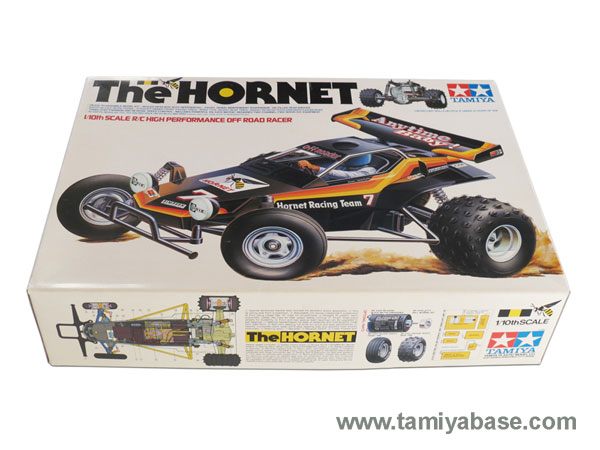
That incredible, dynamic box art of the Hornet as it leans out through a turn and kicks up dust, is actually one of my earliest Tamiya memories.
The first time I ever saw a Tamiya Hornet in action was also the first time I ever saw a Tamiya. I think I was about 8 or 9 years old and my family had been invited to some kind of dinner party at a friend’s house. The friends in question were fairly well known people in the town where I lived, so there were quite a lot of people at this party – maybe 50 or so.
While the parents mostly stayed inside, out in the backyard some of the kids (mostly boys) were busy with some kind of incredibly powerful R/C car. Being a bit younger than these other kids, all I could do was stand back and watch. The car was being launched off a ramp near the back verandah, at full speed, and landing a couple of metres away, at which point it would either flip over or continue to blast dust and dirt as it regained it’s foothold. At the time, my only R/C experiences had been Tandy/Radio Shack type models that would trundle around nice enough, but seeing this thing called a “Hornet” introduced me to a new level of excitement. There was even a sense of violence about it at first – the car seemed tough enough to take the abuse, but the sheer power of it seemed to encourage the other kids to push it to ever higher limits – a sharper ramp, a bigger run-up, and so on.
I knew this must be a really expensive toy, but I later came to realize that it was also just as much a masterpiece of engineering and design as it was a backyard weapon capable of chasing cats and being thrashed around. Perhaps it was the fact that my parents could never really afford to buy a Tamiya during the 1980s, but for whatever reason I developed something of a reverence for the Hornet – and indeed all Tamiyas.
Mind you, I had no idea at first what range of models were available. But when I was about 11, I had the fortune of getting my hands on my first Tamiya catalogue – a glossy, printed gallery of incredible plastic and R/C models that included a page featuring the Hornet.
I must have poured over that catalogue a million times growing up, and here’s the classic product photo of the Hornet as Tamiya intended it to be…
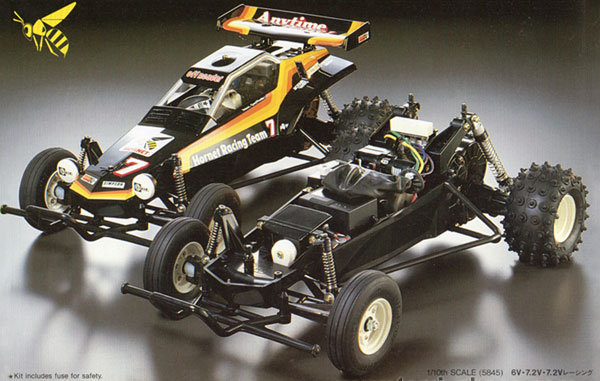
And let’s not forget the original Tamiya promotional video for the Hornet either, which was often screened on a TV set on the counter of your local hobby shop, along with many other promos…
Many collectors of Tamiya cars consider the first 100 Tamiya models to be a kind of “golden era” as these were the cars released at the height of the R/C craze in the 1980s, and are now the most collectible. Among them, the Hornet was the 45th model to be released.
To me though, there’s actually another golden era within that first 100, and it consists mainly of a group of early off-road buggies that were actually inspired by animal concepts and symbolism (plus a few buggies either side of this period). Broadly, you might refer to these buggies as “character cars” due to the fact they came in eye-catching shapes, colours, and with quirky decals and unusual names.
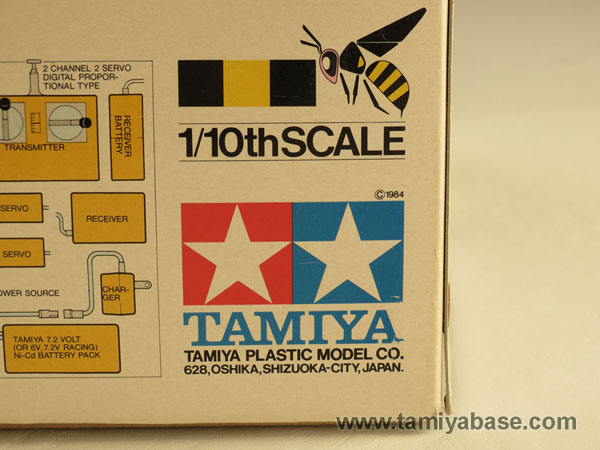
The Hornet is of course based on the Hornet insect, most likely the European Hornet with it’s black and yellow body colouring. But somehow, Tamiya’s designers managed to incorporate subtle references beyond merely the name, and developed this car to remind you of a Hornet insect in a few different ways. Obviously there’s the black body covered in striking yellow-orange-red decals. But also note the angular profile, suspension arms, bumper bar, side nerf bars and so on…all are slender and black, similar to a set of black legs supporting a body. Even the headlights are way down the front – like a pair of eyes.
It’s quite subtle, but the result is a sort of subliminal appeal – the familiar look and colouring of an animal, combined with the name, plus the obvious, aggressive baja buggy shape. It all comes together as one perfect package that somehow was incredibly enticing to children and adults around the world.
And yet despite these aesthetic considerations the car is still 100% functional and uncompromising as an R/C model. This was the genius of Tamiya’s design work during the “character car” era. It’s something they carried across several beautiful buggies. And it’s also something that no other R/C model manufacturer was ever quite able to replicate. Often they would copy Tamiya’s ideas, but they were never quite able to copy Tamiya’s eclectic and unusual inspirations – and pull them off.
It’s no wonder Tamiya’s R/C model sales took off in the early 1980s.
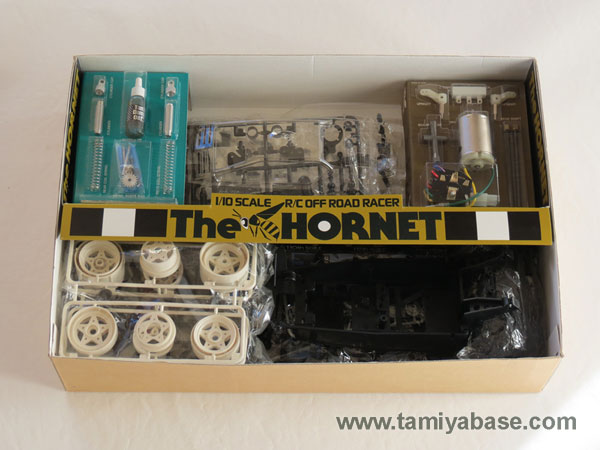
Inside the kit, the Hornet is a relatively simple model to build. It’s a 1/10 scale 2WD utilising a bathtub chassis, to which everything else connects.
Note the blister packaging – a lot of collectors love the way original Tamiya kits were presented, with big dividers covered in pictures of other cars (you could only dream of owning them all!), and blister boxes with lots of little labeled items. (Almost none of the re-released kits come like this).
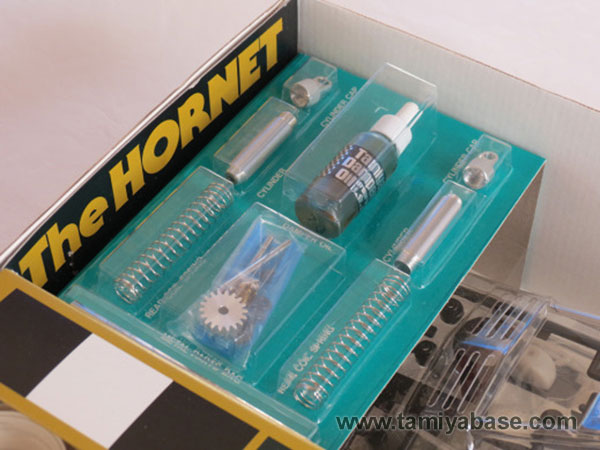
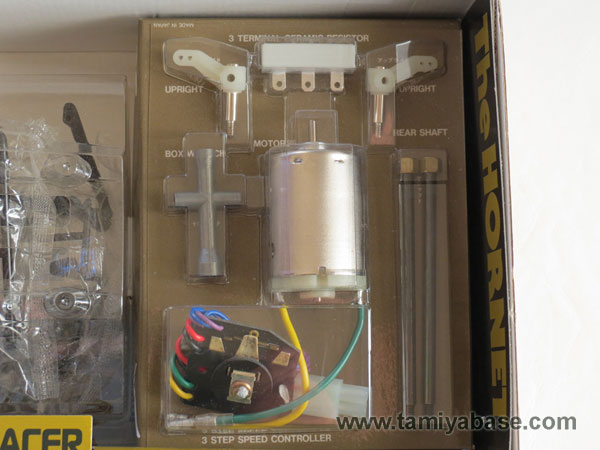
I haven’t mentioned the Tamiya Grasshopper yet, but the Hornet is essentially the Grasshopper’s faster brother. The Grasshopper was released a few months earlier and I will discuss it in detail another time. But the Hornet basically uses the same chassis platform (the chassis actually has “RCC Grasshopper” stamped onto it since the Grasshopper was the first to use it) together with a range of extra features – in particular a Mabuchi 540 motor instead of the Grasshopper’s 380 motor.
It was a fairly lightweight buggy for it’s time too, and the gearbox transfers the motor power quite efficiently so that it’s main strength is straight-line speed. Handling is another matter though, and the car has a tendency to swing it’s tail about and can be a bit of a handful on a loose surface. But this just makes it all the more entertaining. Buggies that run absolutely perfectly can often be a bit boring.
I’ve always really loved Tamiya’s own descriptions of their vehicles, and here’s one of the official Hornet summaries…
Due to it’s extreme maneuverability and high speed we have named this powerful buggy the “HORNET”. With front independent suspension using a friction damper, and rolling rigid rear suspension with oil filled dampers, plus a lightweight polycarbonate body, this aggressive vehicle is aptly named.
Equipped with that polycarbonate body, tough bathtub type chassis, and big flexible front bumper, the car is as tough as they say. If you ever hear anyone complain that their Hornet broke or that this car was inherently weak, remember that there are fools in the world who will drive their R/C vehicles off the rooves of houses, or set them on fire. Under normal use, the Hornet would last a lifetime.
What else…
Well the rear suspension is, as they say “rigid” – there’s no independent suspension at the back. The rear dampers are some really nice, metal, oil-filled units however, that do a reasonable job.
I particularly love the wheels and tyres on this car, which are shared between it and several other Tamiya buggies. Each wheel comes in three-pieces, all joined together by little screws so they are quite elaborate. The tyres all have high side-walls – not that efficient because they aren’t as rigid during cornering as today’s low-profile tyres. But they have a lovely, scale dune-buggy look about them. And the fact they are so fat – particularly at the rear – is all part of that 70s/early 80s-philosophy where a lot of cars in various motorsport around the world (even Formula 1) were thought to perform better if they had massive, fat rear tyres.
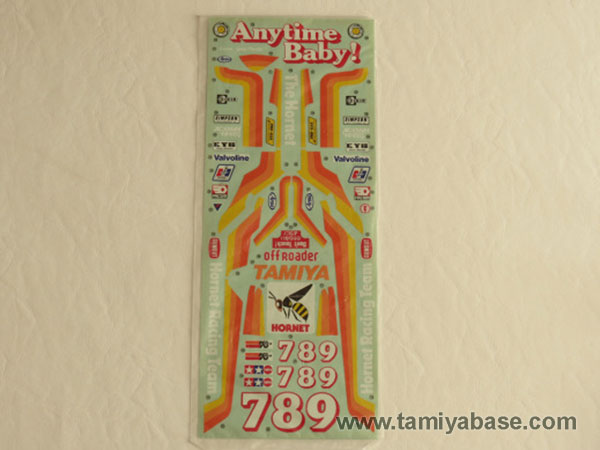
The decals are pretty iconic too. During the 1980s, each Tamiya buggy came with a special slogan, and for the Hornet of course it’s “Anytime, Baby!”. This just added to the car’s character and even little things – like the positioning of the bonnet number “7″ off a bit to one side – are just little touches to add a bit more individuality.
Of course, you could paint and decal your Hornet any way you liked, but as with all my Tamiyas I think I love the original designs too much to deviate. And this is also how the manual suggests you build and detail the model.
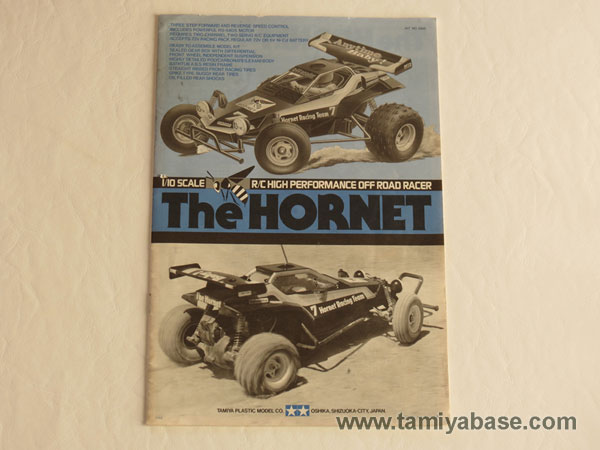
The Grasshopper/Hornet chassis platform with a gearbbox at the back and rigid rear-axle suspension was also such an economical, robust basis for a 2WD R/C buggy that it ended up being copied over the years by dozens of other R/C car makers (both hobby and toy-grade – the Tyco Turbo Hopper is just one example), and in fact the same basic philosophy can still be seen in many R/C toys you can purchase today. So it’s impact on the toy market has been massive.
In the late 1980s I was given my first ever Tamiya – a Hornet of course – by my sister’s fiance, and it was in pretty poor shape at the time. But it became the vehicle that opened up my world to Tamiya R/C cars. Countless afternoons after school were spent running that car around makeshift dirt tracks near my house, usually only for 10-15 minutes at a time though as that’s all a typical 1200mAH Ni-Cd battery would last for in those days! But it was just so entertaining and challenging to fling the buggy around sandy corners, and try to beat little personal-best lap times, that it will always remain one of my very favourite R/C models.
I still have that old Hornet to this day, and it’s now in the process of being restored. So look for another Hornet post sometime in the future, if and when I finally finish that project. (Or if I build an original kit to completion!)
Meanwhile, if you’re looking to relive the fun of an original Tamiya Hornet – just as they were when kids were playing with them back in the 1980s – expect to pay somewhere in the vicinity of US$80-$200 for a used model depending on condition. Original, unbuilt kits are more likely to be somewhere in the range of $350 – $450. Which may seem like a lot, but it’s barely more than the price tag back in the 1980s after you account for 20-30 years worth of inflation.
| At a glance… |
| Scale: 1/10 |
| Length: 40cm |
| Drive: 2WD |
| Motor: RS-540S |
| Gearbox: 1-Speed |
| Digital Proportional: Yes |
| Batteries: 1 x 7.2volt, Optional 4 x AA (Car). Transmitter purchased separately. |
________________________
Article written by TB member Hibernaculum and originally published at www.rctoymemories.com



